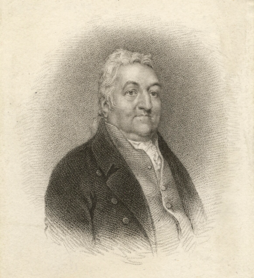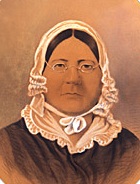See also
| This disambiguation page lists articles associated with the title Star-Spangled Banner. If an internal link led you here, you may wish to change the link to point directly to the intended article. |
Star-Spangled Banner may refer to:
| This disambiguation page lists articles associated with the title Star-Spangled Banner. If an internal link led you here, you may wish to change the link to point directly to the intended article. |

Francis Scott Key was an American lawyer, author, and amateur poet from Frederick, Maryland, who is best known for writing the lyrics for the American national anthem "The Star-Spangled Banner".

The flag of the United States of America, often referred to as the American flag or the U.S. flag, is the national flag of the United States. It consists of thirteen equal horizontal stripes of red alternating with white, with a blue rectangle in the canton bearing fifty small, white, five-pointed stars arranged in nine offset horizontal rows, where rows of six stars alternate with rows of five stars. The 50 stars on the flag represent the 50 states of the United States of America, and the 13 stripes represent the thirteen British colonies that declared independence from the Kingdom of Great Britain, and became the first states in the U.S. Nicknames for the flag include the Stars and Stripes, Old Glory, and the Star-Spangled Banner.

"The Star-Spangled Banner" is the national anthem of the United States. The lyrics come from the "Defence of Fort M'Henry", a poem written on September 14, 1814, by 35-year-old lawyer and amateur poet Francis Scott Key after witnessing the bombardment of Fort McHenry by British ships of the Royal Navy in Baltimore Harbor during the Battle of Baltimore in the War of 1812. Key was inspired by the large U.S. flag, with 15 stars and 15 stripes, known as the Star-Spangled Banner, flying triumphantly above the fort during the U.S. victory.

A national anthem is a country's national song. The majority of national anthems are marches or hymns in style. Latin American, Central Asian, and European nations tend towards more ornate and operatic pieces, while those in the Middle East, Oceania, Africa, and the Caribbean use a more simplistic fanfare. Some countries that are devolved into multiple constituent states have their own official musical compositions for them ; their constituencies' songs are sometimes referred to as national anthems even though they are not sovereign states.

Fort McHenry is a historical American coastal pentagonal bastion fort on Locust Point, now a neighborhood of Baltimore, Maryland. It is best known for its role in the War of 1812, when it successfully defended Baltimore Harbor from an attack by the British navy from the Chesapeake Bay on September 13–14, 1814. It was first built in 1798 and was used continuously by the U.S. armed forces through World War I and by the Coast Guard in World War II. It was designated a national park in 1925, and in 1939 was redesignated a "National Monument and Historic Shrine".

John Stafford Smith was a British composer, church organist, and early musicologist. He was one of the first serious collectors of manuscripts of works by Johann Sebastian Bach.

The Star-Spangled Banner Flag House, formerly the Flag House & Star-Spangled Banner Museum, is a museum located in the Jonestown/Old Town and adjacent to Little Italy neighborhoods of eastern downtown Baltimore, Maryland, United States.

Mary Pickersgill, was the maker of the Star Spangled Banner Flag hoisted over Fort McHenry during the Battle of Baltimore in the War of 1812. The daughter of another noted flag maker, Rebecca Young, Pickersgill learned her craft from her mother, and, in 1813, was commissioned by Major George Armistead to make a flag for Baltimore's Fort McHenry that was so large that the British would have no difficulty seeing it from a great distance. The flag was installed in August 1813, and, a year later, during the Battle of Baltimore, Francis Scott Key could see the flag while negotiating a prisoner exchange aboard a British vessel, and was inspired to pen the words that became the United States National Anthem.

"Columbia, the Gem of the Ocean" is an American patriotic song which was popular in the United States during the 19th and early 20th centuries. Composed c. 1843, it was long used as an unofficial national anthem of the United States, in competition with other songs. It was featured in the 1957 musical The Music Man. In 1969, "Columbia, the Gem of the Ocean" was the music performed by a U.S. Navy Band embarked aboard USS Hornet as one of the ship's helicopters recovered the Apollo 11 astronauts from their capsule named Columbia after a splashdown in the Pacific Ocean.
National symbols of the United States are the symbols used to represent the United States of America.
Amelia S. Bold Fowler, an embroidery teacher and well-known flag preserver, was the master needle worker who restored the original Star Spangled Banner in 1914. By that time, the flag that inspired Francis Scott Key to write the United States national anthem was just "a frail piece of bunting." But Fowler called upon her patented preservation techniques to save it from further deterioration. She used dyed-to-match silk thread and employed ten assistants to reinforce the 1,020-square-foot (95 m2) relic. They anchored it onto Irish linen with 1.7 million of Fowler's special honeycomb patterned, six-sided stitches. It took eight weeks to finish the preservation process. Upon completion, she claimed the restored flag would "defy the test of time," and charged the government $1,243.

"The Star Spangled Banner" is a charity single recorded by American singer Whitney Houston to raise funds for soldiers and families of those involved in the Persian Gulf War. Written by Francis Scott Key, "The Star-Spangled Banner" is the national anthem of the United States. The musical arrangement for Whitney Houston's rendition was by conductor John Clayton. The recording was produced by music coordinator Rickey Minor, along with Houston herself. The recording was included in the 2014 CD/DVD release, Whitney Houston Live: Her Greatest Performances and the US edition of the 2000 release, Whitney: The Greatest Hits.
The Flag of Secession is a song written in 1862 celebrating the secession of the southern states from the Union. The song is sung to the tune of "The Star-Spangled Banner", the national anthem of the United States. The author of the song is unknown. It was included in Frank Moore's (ed.) Rebellion Record, vol. 3, "Poetry and Incidents," p. 38.
In the course of the adoption of "The Star-Spangled Banner" as the national anthem of the United States, a variety of people have either sung or performed the anthem using a variety of instruments and methods. Some of these methods include using only one instrument, such as a guitar or trumpet. Other methods have included singing the anthem using different vocal ranges or even changing some of the words to show support for a home team or for an event. However, veterans groups have spoken out on occasion about these recordings, mainly calling them disrespectful to the country and to the anthem.
The National Anthem Project was a public awareness campaign launched in 2005 as a major initiative of MENC: The National Association for Music Education. At the time of its launch, the National Anthem Project website declared "MENC is sponsoring The National Anthem Project to revive America's patriotism by educating Americans about the importance of The Star-Spangled Banner-both the flag and the song." Sponsored by MENC with major support from the Jeep brand, and other sponsors such as NAMM, Bank of America, and the Gibson Foundation, this campaign, which later used the slogan "to restore America's voice through music education" was MENC's most ambitious project to date. A former First Lady, Laura Bush served as honorary chairperson, with country music's The Oak Ridge Boys as the official musical ambassadors. The stated purpose of the project was originally "to revive America's patriotism," but this was later modified to suggest that its purpose was merely to encourage more singing of the national anthem, or to bring more public attention to the role of music in American schools.
"Nuestro Himno" is a Spanish-language version of the United States national anthem, "The Star-Spangled Banner". The debut of the translation came amid a growing controversy over immigration in the United States.

The Star-Spangled Banner, or the Great Garrison Flag, was the garrison flag that flew over Fort McHenry in Baltimore Harbor during the naval portion of the Battle of Baltimore during the War of 1812. It is on exhibit at the National Museum of American History, Smithsonian Institution. Seeing the flag flying over Fort McHenry on the morning of September 14, 1814, after the battle ended, Francis Scott Key was inspired to write the poem "Defence of Fort M'Henry". These words were written by Key and set to the tune of "To Anacreon in Heaven" by John Stafford Smith, a popular song at the time. It was not until 1931 that the song became the national anthem of the United States.
"Gi Talo Gi Halom Tasi" is the regional anthem of the Northern Mariana Islands.
Land of the Free may refer to:

The Star-Spangled Banner National Historic Trail is a National Historic Trail that commemorates the Chesapeake Campaign of the War of 1812. The 290-mile (467 km) trail was named after "The Star-Spangled Banner," the national anthem of the United States. Consisting of water and overland routes, the trail extends from Tangier Island, Virginia, through southern Maryland, the District of Columbia, the Chesapeake Bay, and Baltimore, Maryland. The trail also contains sites on Maryland's Eastern shore.